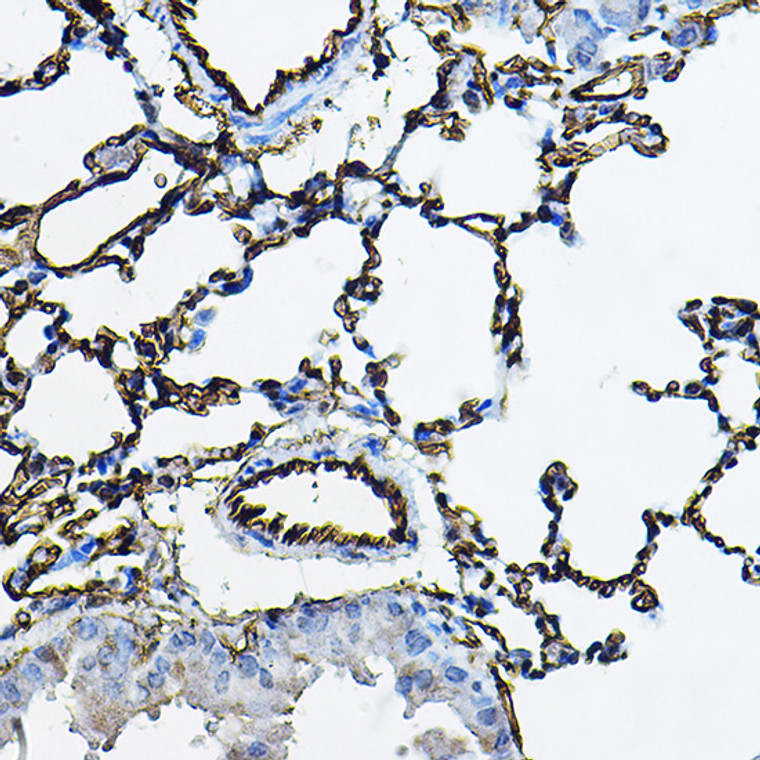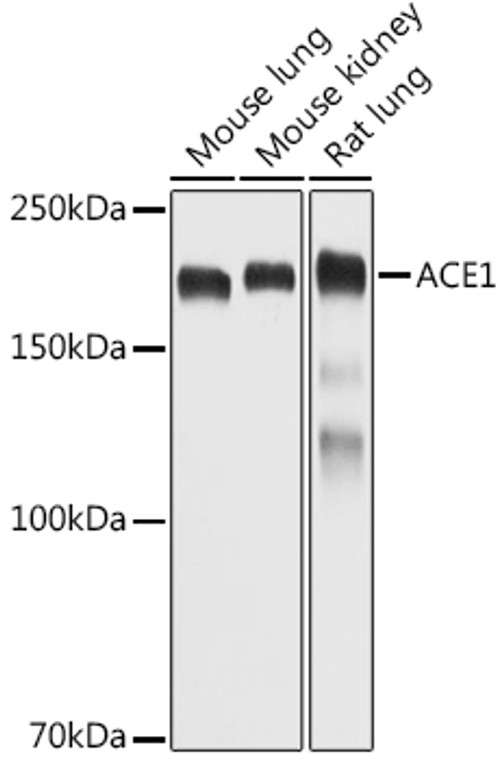| Host: |
Rabbit |
| Applications: |
WB/IHC |
| Reactivity: |
Human/Mouse/Rat |
| Note: |
STRICTLY FOR FURTHER SCIENTIFIC RESEARCH USE ONLY (RUO). MUST NOT TO BE USED IN DIAGNOSTIC OR THERAPEUTIC APPLICATIONS. |
| Short Description: |
Rabbit polyclonal antibody anti-ACE (554-758) is suitable for use in Western Blot and Immunohistochemistry research applications. |
| Clonality: |
Polyclonal |
| Conjugation: |
Unconjugated |
| Isotype: |
IgG |
| Formulation: |
PBS with 0.01% Thimerosal, 50% Glycerol, pH7.3. |
| Purification: |
Affinity purification |
| Dilution Range: |
WB 1:500-1:1000IHC-P 1:50-1:200 |
| Storage Instruction: |
Store at-20°C for up to 1 year from the date of receipt, and avoid repeat freeze-thaw cycles. |
| Gene Symbol: |
ACE |
| Gene ID: |
1636 |
| Uniprot ID: |
ACE_HUMAN |
| Immunogen Region: |
554-758 |
| Immunogen: |
Recombinant fusion protein containing a sequence corresponding to amino acids 554-758 of human ACE11 (NP_000780.1). |
| Immunogen Sequence: |
LHQCDIYRSTKAGAKLRKVL QAGSSRPWQEVLKDMVGLDA LDAQPLLKYFQPVTQWLQEQ NQQNGEVLGWPEYQWHPPLP DNYPEGIDLVTDEAEASKFV EEYDRTSQVVWNEYAEANWN YNTNITTETSKILLQKNMQI ANHTLKYGTQARKFDVNQLQ NTTIKRIIKKVQDLERAALP AQELEEYNKILLDMETTYSV ATVCH |
| Tissue Specificity | Ubiquitously expressed, with highest levels in lung, kidney, heart, gastrointestinal system and prostate. Isoform Testis-specific: Specifically expressed in spermatocytes and adult testis. |
| Post Translational Modifications | Angiotensin-converting enzyme, soluble form: Produced following proteolytic cleavage by secretase enzymes that cleave the transmembrane form in the juxtamembrane stalk region upstream of the transmembrane region. Cleavage can take place at different sites of the juxtamembrane stalk region. Phosphorylated by CK2 on Ser-1299.which allows membrane retention. Phosphorylated on tyrosine residues on its extracellular part, promoting cleavage by secretase enzymes and formation of the soluble form (Angiotensin-converting enzyme, soluble form). |
| Function | Dipeptidyl carboxypeptidase that removes dipeptides from the C-terminus of a variety of circulating hormones, such as angiotensin I, bradykinin or enkephalins, thereby playing a key role in the regulation of blood pressure, electrolyte homeostasis or synaptic plasticity. Composed of two similar catalytic domains, each possessing a functional active site, with different selectivity for substrates. Plays a major role in the angiotensin-renin system that regulates blood pressure and sodium retention by the kidney by converting angiotensin I to angiotensin II, resulting in an increase of the vasoconstrictor activity of angiotensin. Also able to inactivate bradykinin, a potent vasodilator, and therefore enhance the blood pressure response. Acts as a regulator of synaptic transmission by mediating cleavage of neuropeptide hormones, such as substance P, neurotensin or enkephalins. Catalyzes degradation of different enkephalin neuropeptides (Met-enkephalin, Leu-enkephalin, Met-enkephalin-Arg-Phe and possibly Met-enkephalin-Arg-Gly-Leu). Acts as a regulator of synaptic plasticity in the nucleus accumbens of the brain by mediating cleavage of Met-enkephalin-Arg-Phe, a strong ligand of Mu-type opioid receptor OPRM1, into Met-enkephalin. Met-enkephalin-Arg-Phe cleavage by ACE decreases activation of OPRM1, leading to long-term synaptic potentiation of glutamate release. Also acts as a regulator of hematopoietic stem cell differentiation by mediating degradation of hemoregulatory peptide N-acetyl-SDKP (AcSDKP). Acts as a regulator of cannabinoid signaling pathway by mediating degradation of hemopressin, an antagonist peptide of the cannabinoid receptor CNR1. Involved in amyloid-beta metabolism by catalyzing degradation of Amyloid-beta protein 40 and Amyloid-beta protein 42 peptides, thereby preventing plaque formation. Catalyzes cleavage of cholecystokinin (maturation of Cholecystokinin-8 and Cholecystokinin-5) and Gonadoliberin-1 (both maturation and degradation) hormones. Degradation of hemoregulatory peptide N-acetyl-SDKP (AcSDKP) and amyloid-beta proteins is mediated by the N-terminal catalytic domain, while angiotensin I and cholecystokinin cleavage is mediated by the C-terminal catalytic region. Angiotensin-converting enzyme, soluble form: Soluble form that is released in blood plasma and other body fluids following proteolytic cleavage in the juxtamembrane stalk region. Isoform Testis-specific: Isoform produced by alternative promoter usage that is specifically expressed in spermatocytes and adult testis, and which is required for male fertility. In contrast to somatic isoforms, only contains one catalytic domain. Acts as a dipeptidyl carboxypeptidase that removes dipeptides from the C-terminus of substrates. The identity of substrates that are needed for male fertility is unknown. May also have a glycosidase activity which releases GPI-anchored proteins from the membrane by cleaving the mannose linkage in the GPI moiety. The GPIase activity was reported to be essential for the egg-binding ability of the sperm. This activity is however unclear and has been challenged by other groups, suggesting that it may be indirect. |
| Protein Name | Angiotensin-Converting EnzymeAceDipeptidyl Carboxypeptidase IKininase IiCd Antigen Cd143 Cleaved Into - Angiotensin-Converting Enzyme - Soluble Form |
| Database Links | Reactome: R-HSA-2022377 |
| Cellular Localisation | Cell MembraneSingle-Pass Type I Membrane ProteinCytoplasmDetected In Both Cell Membrane And Cytoplasm In NeuronsAngiotensin-Converting EnzymeSoluble Form: SecretedIsoform Testis-Specific: Cell MembraneSecretedThe Testis-Specific Isoform Can Be Cleaved Before The Transmembrane RegionReleasing A Soluble Form |
| Alternative Antibody Names | Anti-Angiotensin-Converting Enzyme antibodyAnti-Ace antibodyAnti-Dipeptidyl Carboxypeptidase I antibodyAnti-Kininase Ii antibodyAnti-Cd Antigen Cd143 Cleaved Into - Angiotensin-Converting Enzyme - Soluble Form antibodyAnti-ACE antibodyAnti-DCP antibodyAnti-DCP1 antibody |
Information sourced from Uniprot.org
12 months for antibodies. 6 months for ELISA Kits. Please see website T&Cs for further guidance








